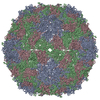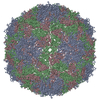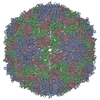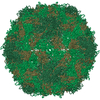+ Open data
Open data
- Basic information
Basic information
| Entry | Database: EMDB / ID: EMD-5710 | |||||||||
|---|---|---|---|---|---|---|---|---|---|---|
| Title | Cryo-EM structure of Poliovirus 135S particles | |||||||||
 Map data Map data | Poliovirus 135S particle | |||||||||
 Sample Sample |
| |||||||||
 Keywords Keywords | cell entry / cryo-electron microscopy / poliovirus / single particle analysis | |||||||||
| Function / homology |  Function and homology information Function and homology informationsymbiont-mediated suppression of host translation initiation / symbiont-mediated suppression of host cytoplasmic pattern recognition receptor signaling pathway via inhibition of RIG-I activity / symbiont-mediated suppression of host cytoplasmic pattern recognition receptor signaling pathway via inhibition of MDA-5 activity / symbiont-mediated suppression of host cytoplasmic pattern recognition receptor signaling pathway via inhibition of MAVS activity / ribonucleoside triphosphate phosphatase activity / picornain 2A / symbiont-mediated suppression of host mRNA export from nucleus / symbiont genome entry into host cell via pore formation in plasma membrane / picornain 3C / T=pseudo3 icosahedral viral capsid ...symbiont-mediated suppression of host translation initiation / symbiont-mediated suppression of host cytoplasmic pattern recognition receptor signaling pathway via inhibition of RIG-I activity / symbiont-mediated suppression of host cytoplasmic pattern recognition receptor signaling pathway via inhibition of MDA-5 activity / symbiont-mediated suppression of host cytoplasmic pattern recognition receptor signaling pathway via inhibition of MAVS activity / ribonucleoside triphosphate phosphatase activity / picornain 2A / symbiont-mediated suppression of host mRNA export from nucleus / symbiont genome entry into host cell via pore formation in plasma membrane / picornain 3C / T=pseudo3 icosahedral viral capsid / host cell cytoplasmic vesicle membrane / nucleoside-triphosphate phosphatase / channel activity / monoatomic ion transmembrane transport / RNA helicase activity / endocytosis involved in viral entry into host cell / symbiont-mediated activation of host autophagy / RNA-directed RNA polymerase / cysteine-type endopeptidase activity / viral RNA genome replication / RNA-directed RNA polymerase activity / DNA-templated transcription / virion attachment to host cell / host cell nucleus / structural molecule activity / proteolysis / RNA binding / zinc ion binding / ATP binding / membrane Similarity search - Function | |||||||||
| Biological species |   Human poliovirus 1 Mahoney Human poliovirus 1 Mahoney | |||||||||
| Method | single particle reconstruction / cryo EM / Resolution: 5.5 Å | |||||||||
 Authors Authors | Butan C / Filman DJ / Hogle JM | |||||||||
 Citation Citation |  Journal: J Virol / Year: 2014 Journal: J Virol / Year: 2014Title: Cryo-electron microscopy reconstruction shows poliovirus 135S particles poised for membrane interaction and RNA release. Authors: Carmen Butan / David J Filman / James M Hogle /  Abstract: During infection, binding of mature poliovirus to cell surface receptors induces an irreversible expansion of the capsid, to form an infectious cell-entry intermediate particle that sediments at 135S. ...During infection, binding of mature poliovirus to cell surface receptors induces an irreversible expansion of the capsid, to form an infectious cell-entry intermediate particle that sediments at 135S. In these expanded virions, the major capsid proteins (VP1 to VP3) adopt an altered icosahedral arrangement to open holes in the capsid at 2-fold and quasi-3-fold axes, and internal polypeptides VP4 and the N terminus of VP1, which can bind membranes, become externalized. Cryo-electron microscopy images for 117,330 particles were collected using Leginon and reconstructed using FREALIGN. Improved rigid-body positioning of major capsid proteins established reliably which polypeptide segments become disordered or rearranged. The virus-to-135S transition includes expansion of 4%, rearrangements of the GH loops of VP3 and VP1, and disordering of C-terminal extensions of VP1 and VP2. The N terminus of VP1 rearranges to become externalized near its quasi-3-fold exit, binds to rearranged GH loops of VP3 and VP1, and attaches to the top surface of VP2. These details improve our understanding of subsequent stages of infection, including endocytosis and RNA transfer into the cytoplasm. | |||||||||
| History |
|
- Structure visualization
Structure visualization
| Movie |
 Movie viewer Movie viewer |
|---|---|
| Structure viewer | EM map:  SurfView SurfView Molmil Molmil Jmol/JSmol Jmol/JSmol |
| Supplemental images |
- Downloads & links
Downloads & links
-EMDB archive
| Map data |  emd_5710.map.gz emd_5710.map.gz | 225.1 MB |  EMDB map data format EMDB map data format | |
|---|---|---|---|---|
| Header (meta data) |  emd-5710-v30.xml emd-5710-v30.xml emd-5710.xml emd-5710.xml | 12 KB 12 KB | Display Display |  EMDB header EMDB header |
| Images |  emd_5710.tif emd_5710.tif | 8.9 MB | ||
| Archive directory |  http://ftp.pdbj.org/pub/emdb/structures/EMD-5710 http://ftp.pdbj.org/pub/emdb/structures/EMD-5710 ftp://ftp.pdbj.org/pub/emdb/structures/EMD-5710 ftp://ftp.pdbj.org/pub/emdb/structures/EMD-5710 | HTTPS FTP |
-Validation report
| Summary document |  emd_5710_validation.pdf.gz emd_5710_validation.pdf.gz | 377.9 KB | Display |  EMDB validaton report EMDB validaton report |
|---|---|---|---|---|
| Full document |  emd_5710_full_validation.pdf.gz emd_5710_full_validation.pdf.gz | 377.5 KB | Display | |
| Data in XML |  emd_5710_validation.xml.gz emd_5710_validation.xml.gz | 7.1 KB | Display | |
| Arichive directory |  https://ftp.pdbj.org/pub/emdb/validation_reports/EMD-5710 https://ftp.pdbj.org/pub/emdb/validation_reports/EMD-5710 ftp://ftp.pdbj.org/pub/emdb/validation_reports/EMD-5710 ftp://ftp.pdbj.org/pub/emdb/validation_reports/EMD-5710 | HTTPS FTP |
-Related structure data
| Related structure data |  3j48MC M: atomic model generated by this map C: citing same article ( |
|---|---|
| Similar structure data |
- Links
Links
| EMDB pages |  EMDB (EBI/PDBe) / EMDB (EBI/PDBe) /  EMDataResource EMDataResource |
|---|---|
| Related items in Molecule of the Month |
- Map
Map
| File |  Download / File: emd_5710.map.gz / Format: CCP4 / Size: 238.4 MB / Type: IMAGE STORED AS FLOATING POINT NUMBER (4 BYTES) Download / File: emd_5710.map.gz / Format: CCP4 / Size: 238.4 MB / Type: IMAGE STORED AS FLOATING POINT NUMBER (4 BYTES) | ||||||||||||||||||||||||||||||||||||||||||||||||||||||||||||||||||||
|---|---|---|---|---|---|---|---|---|---|---|---|---|---|---|---|---|---|---|---|---|---|---|---|---|---|---|---|---|---|---|---|---|---|---|---|---|---|---|---|---|---|---|---|---|---|---|---|---|---|---|---|---|---|---|---|---|---|---|---|---|---|---|---|---|---|---|---|---|---|
| Annotation | Poliovirus 135S particle | ||||||||||||||||||||||||||||||||||||||||||||||||||||||||||||||||||||
| Projections & slices | Image control
Images are generated by Spider. | ||||||||||||||||||||||||||||||||||||||||||||||||||||||||||||||||||||
| Voxel size | X=Y=Z: 1.37 Å | ||||||||||||||||||||||||||||||||||||||||||||||||||||||||||||||||||||
| Density |
| ||||||||||||||||||||||||||||||||||||||||||||||||||||||||||||||||||||
| Symmetry | Space group: 1 | ||||||||||||||||||||||||||||||||||||||||||||||||||||||||||||||||||||
| Details | EMDB XML:
CCP4 map header:
| ||||||||||||||||||||||||||||||||||||||||||||||||||||||||||||||||||||
-Supplemental data
- Sample components
Sample components
-Entire : Poliovirus 135S particle
| Entire | Name: Poliovirus 135S particle |
|---|---|
| Components |
|
-Supramolecule #1000: Poliovirus 135S particle
| Supramolecule | Name: Poliovirus 135S particle / type: sample / ID: 1000 Details: Native virus 160S is converted by heat treatment to 135S. Oligomeric state: icosahedrally ordered capsid: 60 copies of VP1, VP2, VP3 Number unique components: 1 |
|---|---|
| Molecular weight | Experimental: 8.6 MDa / Theoretical: 9 MDa |
-Supramolecule #1: Human poliovirus 1 Mahoney
| Supramolecule | Name: Human poliovirus 1 Mahoney / type: virus / ID: 1 / Name.synonym: Poliovirus type 1 (strain Mahoney) / NCBI-ID: 12081 / Sci species name: Human poliovirus 1 Mahoney / Sci species strain: Mahoney / Virus type: VIRION / Virus isolate: STRAIN / Virus enveloped: No / Virus empty: No / Syn species name: Poliovirus type 1 (strain Mahoney) |
|---|---|
| Host (natural) | Organism:  Homo sapiens (human) / synonym: VERTEBRATES Homo sapiens (human) / synonym: VERTEBRATES |
| Host system | Organism:  Homo sapiens (human) / Recombinant cell: HeLa Homo sapiens (human) / Recombinant cell: HeLa |
| Molecular weight | Experimental: 8.6 MDa / Theoretical: 9 MDa |
| Virus shell | Shell ID: 1 / Diameter: 308 Å / T number (triangulation number): 1 |
-Experimental details
-Structure determination
| Method | cryo EM |
|---|---|
 Processing Processing | single particle reconstruction |
| Aggregation state | particle |
- Sample preparation
Sample preparation
| Concentration | 0.3 mg/mL |
|---|---|
| Buffer | pH: 7.4 / Details: 2 mM CaCl2, 20 mM HEPES |
| Grid | Details: glow-discharged holey carbon-grids (200 mesh C-flat grids) |
| Vitrification | Cryogen name: ETHANE / Chamber temperature: 90 K / Instrument: HOMEMADE PLUNGER Details: Vitrification carried out in ambient atmosphere. Ethane cooled by liquid nitrogen. Method: Blotted manually before plunging into liquid ethane |
- Electron microscopy
Electron microscopy
| Microscope | FEI TECNAI F20 |
|---|---|
| Temperature | Min: 90 K / Max: 93 K / Average: 90 K |
| Alignment procedure | Legacy - Astigmatism: Objective lens astigmatism was corrected. |
| Date | Feb 28, 2011 |
| Image recording | Category: CCD / Film or detector model: TVIPS TEMCAM-F415 (4k x 4k) / Number real images: 1020 / Average electron dose: 15 e/Å2 |
| Tilt angle min | 0 |
| Tilt angle max | 0 |
| Electron beam | Acceleration voltage: 200 kV / Electron source:  FIELD EMISSION GUN FIELD EMISSION GUN |
| Electron optics | Illumination mode: FLOOD BEAM / Imaging mode: BRIGHT FIELD / Cs: 2 mm / Nominal defocus max: 2.0 µm / Nominal defocus min: 0.98 µm / Nominal magnification: 62000 |
| Sample stage | Specimen holder: Side entry liquid nitrogen-cooled cryo specimen holder Specimen holder model: GATAN LIQUID NITROGEN |
| Experimental equipment |  Model: Tecnai F20 / Image courtesy: FEI Company |
- Image processing
Image processing
| Details | The particles were selected using an automatic selection program. |
|---|---|
| CTF correction | Details: Each micrograph |
| Final reconstruction | Algorithm: OTHER / Resolution.type: BY AUTHOR / Resolution: 5.5 Å / Resolution method: FSC 0.143 CUT-OFF / Software - Name: FREALIGN / Number images used: 117330 |
-Atomic model buiding 1
| Initial model | PDB ID: Chain - #0 - Chain ID: 0 / Chain - #1 - Chain ID: 1 / Chain - #2 - Chain ID: 3 |
|---|---|
| Software | Name: COOT, REFMAC |
| Details | Most of the model was docked, with specific areas of discrepancy fitted. The fitting was rigid body with flexible fitting or deletion of selected polypeptide segments. Rigid bodies for VP1, VP2, VP3, and the VP3 beta tube were defined to include beta barrels and non-covalently attached polypeptides. Each rigid body was repeatedly fitted manually and then refined. Disordered polypeptide segments were removed. Several rearranged segments were included as approximate backbone traces and refined. |
| Refinement | Space: RECIPROCAL / Protocol: RIGID BODY FIT Target criteria: mean amplitude-weighted cosine of the phase difference |
| Output model |  PDB-3j48: |
 Movie
Movie Controller
Controller
















 Z (Sec.)
Z (Sec.) Y (Row.)
Y (Row.) X (Col.)
X (Col.)






















